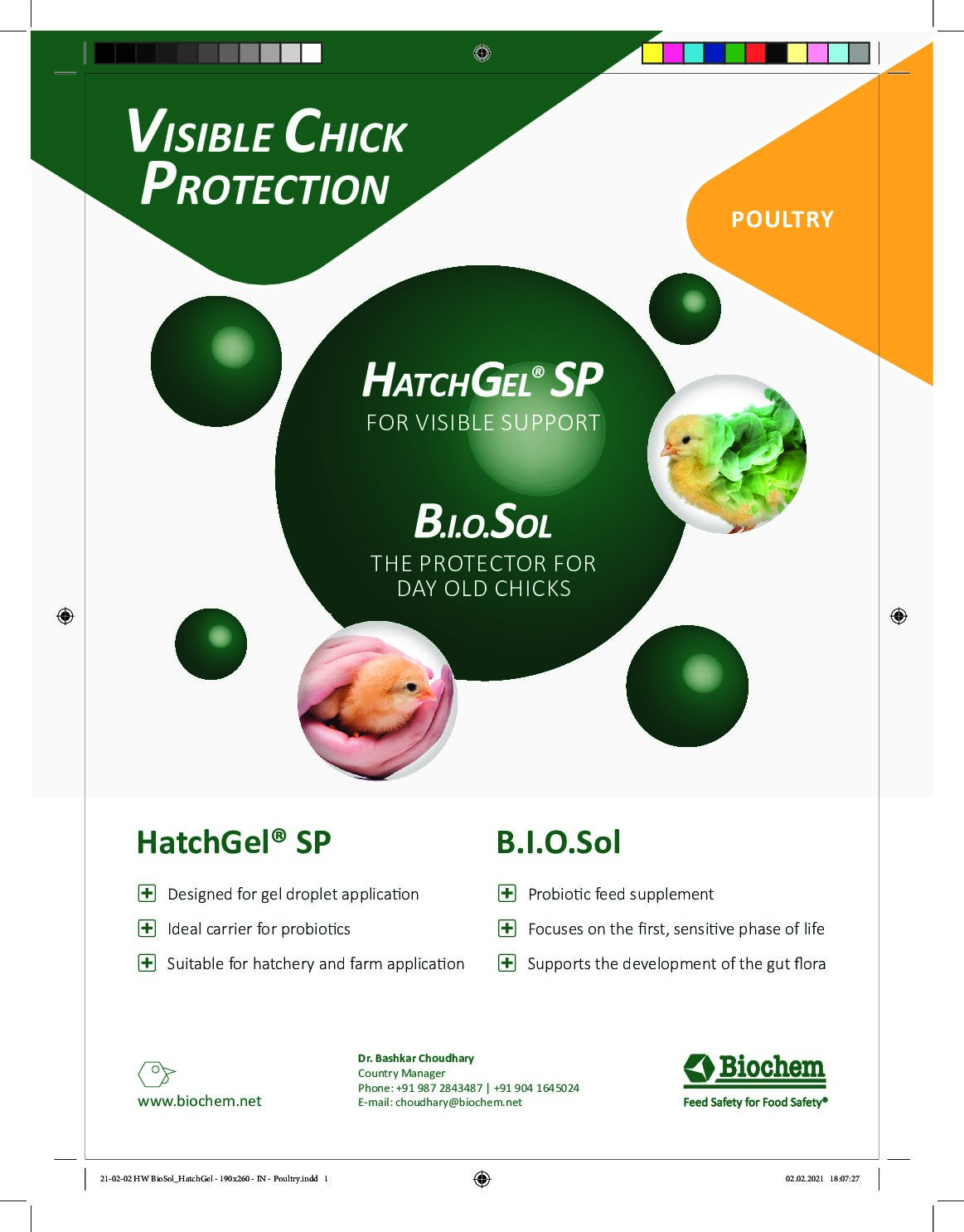From trend to necessity : The early care of day-old chicks is key to raising healthy robust poultry
Authors:
Melanie Frisch (Product Manager at Biochem Zusatzstoffe GmbH)
In poultry, most health risks affect the digestive tract, ranging from dysbacteriosis, parasites and impaired digestion, to the spread of foodborne diseases. The composition of the intestinal microbiota is a decisive factor for gut health, but in young chicks it is neither established nor balanced.
While genetic improvement causes for shorter fattening periods and thus a shorter life span, it also increases the importance of providing the best possible care of the chicks’ microbiota as early as possible. Potential health risks need to be eliminated as time is too short for compensation later on, putting performance and profit at risk. To support the stabilization of the intestinal microbiota, early colonization of the gut with beneficial bacteria is a key factor for the prevention of digestive disorders and performance depression. The use of probiotics in poultry feed is a widespread, well-researched tool for this purpose. They are known to support reduction of pathogens, improvement of nutrient digestibility and absorption, as well as gut morphology and immune system. Especially with the awareness of antibiotic resistances and overuse in mind, probiotics can be an excellent health support.
Products containing lactic acid bacteria are reported to be very suitable for this indication as they show a fast replication rate and quick colonization of the intestinal tract. During the last years a commercial lactic acid-containing supplement (B.I.O.Sol, Biochem Zusatzstoffe) was extensively tested in field trials. Main target of these trials was to confirm the reliability and constancy of the results achieved with a use of the supplement during the first three days via drinking water application. In a trial on a commercial broiler farm in Northwestern Germany with two houses with 45,000 broilers (Ross 308) each, the product was evaluated for 5 fattening cycles of 42 days (thinning at day 28). The houses for treatment group and control group were changed after each cycle. Across all cycles the animals of the treatment house showed less mortality during first week (Ø -31%) and an improvement in daily weight gain (Ø +3.25%) during the 42-day fattening period (Figure 1 and 2).
Figure 1: Effect of B.I.O.Sol (Treatment) on mortality of broiler chickens during first week of life in 5 subsequent fattening cycles compared to non-treated animals (Control) (Frisch et al., 2019)
Figure 2: Effect of B.I.O.Sol (Treatment) on average daily weight gain of broiler chickens in 5 subsequent fattening cycles of 42 days each compared to non-treated animals (Control) (Frisch et al., 2019)
Globalized trade structures are a cause for a longer time span between hatch and housing. It became obvious that the care of the chicks and the provision with beneficial, health-supporting feed supplements and nutrients should start in the hatchery. When it comes to the provision of probiotics, systems that hold feed and water in brooding temperatures for up to 72 hours are not ideal in regards to hygiene. One option to provide probiotics is the method of spray application. The compatibility of probiotics with some vaccines is also proven, making a vaccine and a probiotic applicable in one step.
A quite new and quickly establishing variation of the classical spray application is the gel droplet application. This rather new technology bears various benefits. Similar to the spray, a soft gel is dropped onto the chicks while they are moved through the hatchery in the crates. As opposed to water based coarse spray, the gel eliminates several problems:
– No wetting of the feathers, reducing hypothermia
– No spread of (probiotic) bacteria with the spray mist
– No need for cost intensive changeover of hatchery equipment
– Excellent, visually checkable oral intake
To effectively deliver probiotic solutions, the company Biochem set to develop a new gel carrier (HatchGel SP). It is the first gel that is fully conform to European feed legislation. Furthermore, the gel is the first of its kind that surpasses the mere function of a carrier for probiotics and coccidia vaccines. Innovative ingredients and a well-thought-out composition provide micronutrients and certain prebiotic effects, which allow an additional impact for gut development.
In a recent trial, male broilers (Ross 308) were investigated for gut morphology of the ileum. Animals in the 2 treatment groups received B.I.O.Sol via drinking water until day 3. The second treatment group in addition received B.I.O.Sol via gel application (HatchGel SP) at the first day. Histological investigation of villus length in the ileum was done via hematoxylin-eosin (HE) staining (Figure 3) in ileal samples from 23-day-old birds. The results showed that the animals receiving B.I.O.Sol showed numerically higher values in villi length compared to the control animals, indicating a positive effect from early feeding of lactic acid bacteria on the gut development in the later phase of life.
Figure 3: Histological investigation of villus length via hematoxylin-eosin (HE) staining.
Figure 4: Villi length in the ileum of broiler chickens at day 23 of age after different treatment on day 1-3 of age (Means, SD, n=8) (Frisch et al., 2020)
In conclusion, the application of lactic acid bacteria-based concepts in the first days of life are a beneficial tool for supporting early establishment of desired gut microbiota and the stimulation of gut development. In addition to application via drinking water, the use of a gel allows to generate a positive impact already in the hatchery, during transport, and in the first hours on the farm. Reduction of mortality rates in the first week of life, as well as improvement of whole-life performance are potential positive effects from early support of gut health in broilers.



